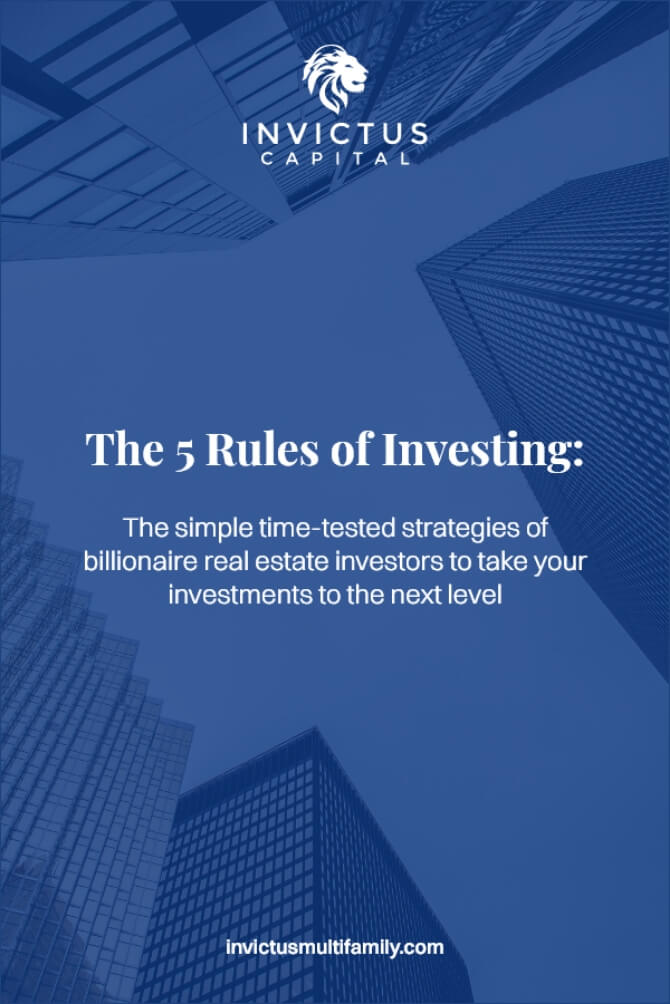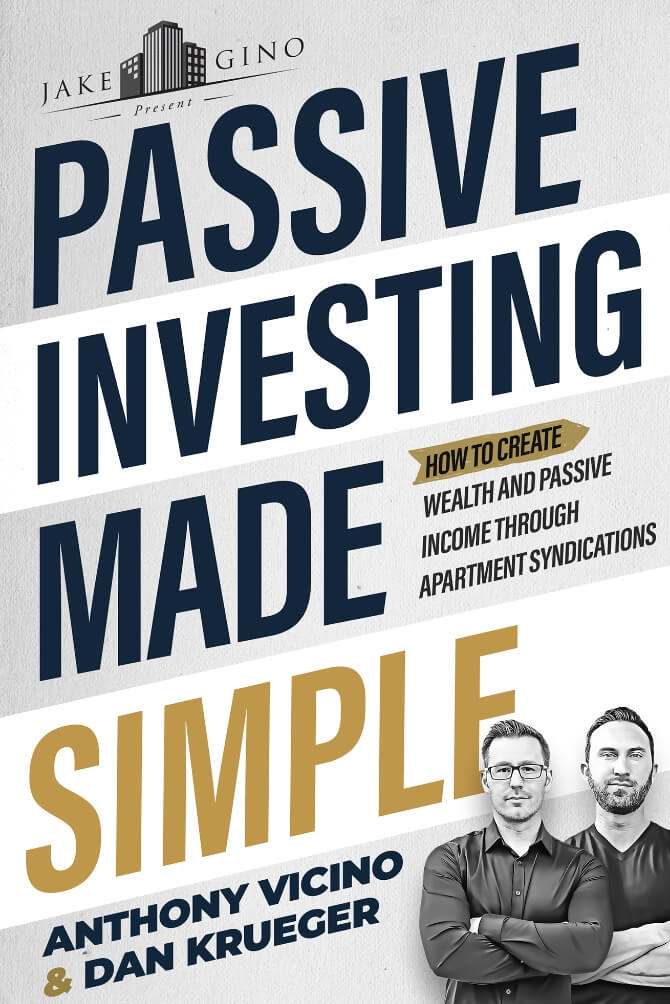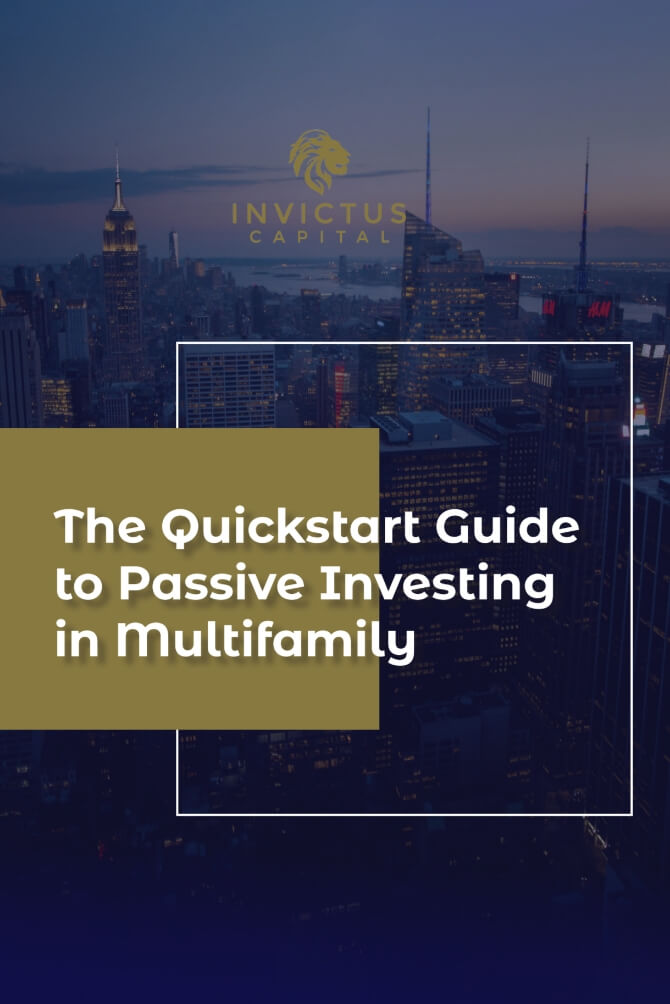For today’s episode, we will be discussing Setting Your Investment Parameters.
What the heck is Investment Parameters?
Walking through where people fall on the spectrum and tiring some metrics to particular investment vehicles.
Should the investment yield high only cash flow? What about appreciation?
We will talk about these things…and more in another episode of Multifamily Investing Made Simple in under 10 minutes.
Tweetable Quotes:
“It’s not about what you make, it’s about what you keep.” – Anthony Vicino
“I think it’s very important that people sit down and really think about where they fall on that spectrum, identify those parameters, and make sure that they look for them when they’re out there looking at opportunities.” – Dan Krueger
LEAVE A REVIEW if you liked this episode!!
Keep up with the podcast! Follow us on Apple, Stitcher, Google, and other podcast streaming platforms.
To learn more, visit us at https://invictusmultifamily.com/
**Want to learn more about investing with us?**
We’d love to learn more about you and your investment goals. Please fill out this form and let’s schedule a call: https://invictusmultifamily.com/contact/
**Let’s Connect On Social Media!**
LinkedIn: https://www.linkedin.com/company/11681388/admin/
Facebook: https://www.facebook.com/invictuscapitalventures/
YouTube: https://bit.ly/2Lc0ctX

Anthony Vicino: [00:00:02] Hello and welcome to multifamily investing made simple in Under Ten Minutes, this is the podcast where we take the complexity out of real estate investing so that you can start taking action today. And today we’re going to be taking the complexity out of setting your investment parameters and we’re going to do it in under 10 minutes. So, Dan, what does it mean to set our investment parameters?
Dan Krueger: [00:00:22] What the heck is investment parameters? Right. That’s the first question. When we say investment parameters, what we’re really talking about is what are your goals? What are you trying to accomplish? There are more than likely, even if you haven’t actually gone through this mental exercise, some KPIs or some metrics relative to an investment that you’re going to be looking at that are more important to you than others. So to kind of illustrate this concept, I can list off some examples, right? We might have an individual who’s 25 years old, you know, within their first couple of years of working life after college. They’ve got their whole life ahead of them. They’ve got, you know, a little bit of money and they’ve got a job and they’re kind of doing their own thing. And what they’re really trying to do is supplement their 401k and they want to start investing in something other than their four Wingate 401k to have some other kind of retirement resource and maybe even get a little bit of cash in the meantime.
Dan Krueger: [00:01:18] Right.
Dan Krueger: [00:01:20] Compare that to an old individual, someone who’s 70 years old. They’ve already accumulated most of their wealth. And at this point, they’re really just trying to maximize the yield that they can get because they’re retired. Their income right now maybe is Social Security and they’re drawing on their phone cards. So they’re looking to get maximum annual yield and they’re not necessarily concerned about growing their wealth over time. They’re trying to maximize what they’ve already have accumulated and try to increase their quality of life as much as possible. But they have. So those are two very different individuals and they’ve got two very different sets of parameters. The young guy might be concerned, might not be that concerned with the yields, the cash flow, and is really kind of looking at how can I double or triple my money as many times as possible over the next 30 years, regardless of what those quarterly cash flow checks look like. Right. I’ve got a job that pays is kind of most important. I want to try to multiply my money over the next 30 years. And that older individual has got a completely inverted perspective.
Dan Krueger: [00:02:19] So the investment parameters for these people will be quite different, right? Cash flow is kind of a non-issue for the young guy. He wants something that’s going to give him is the highest equity. It’s going to let him double his money as quickly as possible over the next 30 years. And the older individual is probably looking really heavily at cash flow, wanting to mitigate downside risk. And they’re not really looking for a lot of appreciation. So those are a bunch of different parameters that these two individuals are looking at. And they’ve got two very different goals and objectives. And I think it’s a really important exercise for people to sit down and figure out which camp they fall in. And it’s not binary either. In between those two people, there’s a whole continuum of options there. So it’s really just, I think it’s very important that people sit down and really think about where they fall on that spectrum, identify those parameters, and make sure that they look for them they’re out there looking at opportunities.
Anthony Vicino: [00:03:13] Yeah. Let’s walk through these and tie some of these metrics or KPIs, let’s say, to a particular investment vehicle and what might be well suited for it. So let’s say I’m young, I’m twenty-five, I’m a spring chicken, just starting my investing career and I’m looking to maximize my capital. I need to get that capital stack and I don’t need to live off this money for another ten, fifteen, twenty years. I just need it grows.
Dan Krueger: [00:03:37] And what am I looking at? Bitcoin, just a coin.
Dan Krueger: [00:03:43] Yeah. No, I think what you just described there was somebody who’s got a little bit higher tolerance for risk. Theoretically, if you got into something that was a little bit riskier and it didn’t quite work out, you’ve got forty years to make up for it. So right off the bat, we might be looking at some things that might have a little bit different risk profile than an older individual. Sounds like the cash flow is of less concern than the the the the growth of your capital and the wealth accumulation. So those for that individual, we’d say your parameters are cash flow is not that important. I could probably infer that you’re probably in a lower tax bracket. So mitigating your tax liability is probably not something you’re thinking about at twenty-five. I know I wasn’t. So you’re probably looking at, you know, your appreciation potential. Right? That’s probably the big thing. You’re looking for the cash on cash return, the tax nuances and the risk profile might be lower down on the totem pole of things that you’re concerned with. And you’re really just looking at what’s going to have the biggest return on the biggest total equity appreciation, I guess, as well, I should say.
Anthony Vicino: [00:04:51] Yes, three particular strategies or types of deals you might look at that is a ground up new development. So some developers are going to go in. They’re going to build a 100 unit class, A building in. Heart of downtown, it’s going to take him five years to be showing any type of return, but once they him no cash flow, but bam, once it’s up and running, there’s big appreciation like north of 20 percent IRR. So great return. And a lot can change in that time. And you can change your risk profile.
Dan Krueger: [00:05:19] Right. With development, you start this project and really you’re breaking ground a year later and you’re actually collecting money almost two years later. Things could change. So definitely a little bit higher risk.
Anthony Vicino: [00:05:29] Another one is looking like an opportunistic value add play, which is going into a class D building that needs a heavy reposition. A lot of CapEx. Maybe it’s in a neighborhood that’s a little bit more speculative, but you have faith that in the next five, six years it’s going to get nice and nice and popular and you want to get on at ground level. So it might not be cash flowing, might be really risky in the early years. But if it all comes out in the wash, you might stand to appreciate it a lot. So that could be a really powerful play or just a normal value add a multifamily deal. You know, the types that we do where we go and we force appreciation, there’s decent cash flow and there’s really good appreciation as well. So that might be a good, good option for a younger investor. Now, let’s move to somebody who’s 35 or 40 years old to earning 200000 dollars a year. They have a family. And what they’re really looking for is a little bit of a safer place. They’re looking to offset their taxes. They don’t want to lose money, but they’re also still young enough where they could afford to take some risk. What should they look at?
Dan Krueger: [00:06:28] I think the space we plan, which is kind of like what we call the Goldilocks zone, that kind of value add a property that’s not in a war zone, that’s in a good neighborhood. It’s already gentrified. We don’t need to wait for, you know, the big shirt, the big ship that is the neighborhood to kind of slowly turn and make its move. It’s already established as a nice spot, but there’s still some meat on the bone, whether it be an operator or a manager or owner that didn’t really push the rents as high as they could. They didn’t know how to run the business and the expenses were all out of whack. So, you know, that’s kind of the Goldilocks zone where we get the cash flow because it’s, you know, a good neighborhood, somewhat stabilized, but we still have meat on the bone to go in and enforce appreciation. So we kind of hang out in that middle space. Might just be because we’re about 35 years old, just we are kind of those people.
Anthony Vicino: [00:07:18] That is. Yeah, it’s exactly our investment parameters. You know, we don’t want to lose money, but we’re OK if we do because we have time to make it back. But we do air on the side of being risk-averse inherently. And so we want to have the big, you know, pop the end. We want that appreciation, but we don’t want to lose sleep at night on a speculative deal in a war zone. And so I would say you could also look at, you know, still, some new development that could still be a really good, solid play that offers a lot of potential upside with not a ton of downside if it’s in an established market. I think when you’re younger, you could afford to look at some development deals and some more speculative markets. But at this age, you’re looking at some pretty well-established methods to justify it. So let’s move on then to our older individual. They’re getting up there in years. They’re looking for a nice, solid, safe conservative play. They can’t afford to lose any money and they, in fact, need to start living off of this cash flow.
Anthony Vicino: [00:08:12] What are they looking at?
Dan Krueger: [00:08:15] We’ll cash flow. Right. That’s going to be one of the big ones. And somewhere around, I’d say, after you turn thirty, is when you start to care about taxes, usually in your twenties, it’s a non-issue. So maybe even that category of person we just talked about, the tax situation might come into play, especially those individuals that might be in the higher end of the income range for their age. You know, if they’re a high-paid professional, maybe their lawyer, maybe their doctor, they own a medical practice of some kind. You know, they’re collecting some pretty big paychecks. Once you get past thirty, the whole tax side of things is probably going to start to come onto your radar. And that could be a parameter that you start to care about. Now, real estate, a very tax advantageous asset. There’s a lot of people who invest in these types of deals primarily to get the reduction in their tax liability. So the tax liability might be of concern. But I think as you get older, it becomes less about trying to grow your wealth, more about trying to maintain it and get as much cash flow as possible. So these people are going to be looking at very stabilized assets that are already running well, might not have as much appreciation, but you get high cash flow from day one. And you might have to start asking some questions about the tax situation and looking at deals, whether it’s cost segregation studies, to maximize those tax benefits for the investors.
Anthony Vicino: [00:09:35] Absolutely. So they might be looking at a class A or Class B building nice and solid, stable cash flow, but not a lot of appreciation. And they’re getting that tax benefit as well because it’s not about what you make, it’s about what you keep. So that is the setting your investment parameter from a really high level. Those are just some buckets to start thinking about this through. Dan and I are really big proponents about understanding how you plan to get out before you go in and understanding where you’re going in life and before you. Down this investment path, make sure that you understand what it is you hope to get out of it. So hopefully this was helpful. If you have questions, reach out to us. Otherwise, we’ll catch you guys next week.


